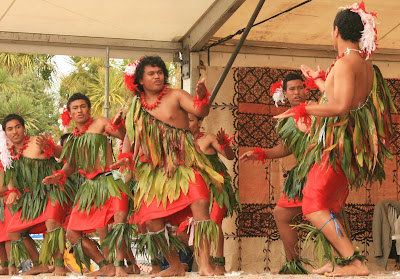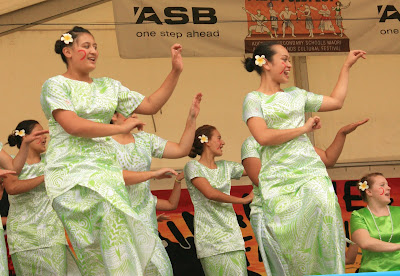The Auckland Secondary Schools Maori and Pacific Islands Cultural Festival (Poly Fest) has become the largest of its kind in the world. This event is proudly hosted by Manukau City, on Mara South suburb of Auckland where almost all the Maori population is condensed, and I had the immense pleasure to attend, invited by my school, St. Cuthberts' College.
Maori

The Maori, the first inhabitants of this land, the most proud of it, the hearthy people, the maori.
The entrance, the boss and couple of the tribe do their thiumphal entrance, showing their respect to the audience. It is astonishing.

Titi Torea, the art of hitting double sticks.
There are many forms for playing titi torea, starting from the simple ones where a player learns to change hands with the sticks they have, through to the sticks coming from behind and having to be caught. Both children and adults play titi torea. Competitions are sometimes held, with the aim being for each team to complete a certain set of patterns without going out of beat or dropping any.

The Poi dance
The women of the tribe will then chant for Papa and Rangi, songs inherited of lines of ancestors. They will dance offer a dance of poi.
There are different thoughts on the origin of the poi. The flexibility and dexterity of the poi have, in the past been a means of training warriors.
The long poi represent the oars of our Tupuna
Women of High rank were trained in the art of the long poi, manipulating up to 4 at a time.
The long poi represent the oars of our Tupuna
Women of High rank were trained in the art of the long poi, manipulating up to 4 at a time.
The KAPA HAKA, the war dance

The most impressive of all the dances I've ever seen. It makes you tremble, it transports you 1000 years ago, it is scary, it is defiant, it is great.
Timing Each item will have a certain beat and speed, some items have tempo changes. It is important to ensure that the timing is accurate. The change from one action to another is also part of the timing. A good group have the actions synchronised as well as the foot work.
Footwork Footwork helps with timing. Different areas have different styles of footwork, some areas lift the foot and some areas don't. It is important to recognise and appreciate different areas' styles, as this reflects their tikanga.
Stance The way a performer holds themselves is also important. Confidence, comes over time.
Wiri - trembling of the hands. The wiri is a side to side movement of the whole hand and is not a wriggling of the fingers. The wiri represents the world around us, from the shimmering of the waters of a bright sunny day, to the heat waves rising from the ground to the wind rustling the leaves of the trees.
Footwork Footwork helps with timing. Different areas have different styles of footwork, some areas lift the foot and some areas don't. It is important to recognise and appreciate different areas' styles, as this reflects their tikanga.
Stance The way a performer holds themselves is also important. Confidence, comes over time.
Wiri - trembling of the hands. The wiri is a side to side movement of the whole hand and is not a wriggling of the fingers. The wiri represents the world around us, from the shimmering of the waters of a bright sunny day, to the heat waves rising from the ground to the wind rustling the leaves of the trees.

Unlike other indigenous dance forms, kapa haka is unique in the fact that the performers must sing, dance, have expression as well as movement all combined into each item.

Kapa Haka could be seen as sign language, as each action has a meaning, which ties in with the words. For example, if the hand is by the ear, this would probably tie in with the word whakarongo which means to listen.

Showing the tonge to your opponent shows how strong you are and defies him.
COOK ISLANDS
The Cook Island dance is a kind of "Hawaian" dance. You know really beatiful girsl moving their bumps and hips very, very fast, at the rythm of the strepid drums and sticks.
The Cook Island dance is a kind of "Hawaian" dance. You know really beatiful girsl moving their bumps and hips very, very fast, at the rythm of the strepid drums and sticks.
The maoris in Aotearoa are believed to came principally from the Cook Islands, as you can see, the ressemblance is huge.

The dances of the Cook islands are renowned throughout Polynesia for their expression and sensuality. Cook Islands dancing dates back thousands of years with many of the dances being based on ancient stories - stories that tell a tale of love or adventure and in some cases both
TONGA

Toonga is another beautiful island of the Polynesia with white sand beaches, waterfalls and native forest. It is a kingdom, the economy is not the best, based primarily in fishing and tourism, therefore lots of people emigrate to New Zealand, country with which they have a Seasonal Work Permit agreement, easily awarded to the Islanders keen to work as Fruit pickers and harvesters (and why abandone a beautiful life in a hut, fishing and hunting for emigrating to a deshumanized city where everybody will treat you as a foreigner, even worse for not being white, and it will be tremendously difficult to achieve anything? Misteries of the modern times).

Anyway, dancing in the Kingdom of Tonga is a dignified, graceful portrayal of the choreographer’s art. Another characteristics of Tongan dancing is the importance of two kinds of hand clapping each of which is named – a flat high pitched (called pasi in Tongan) and a cross clap with cupped hands which emits a lower hollow sound (fu).
Soke(ball de bastons a Catalunya) is a Tongan group dance performed with sticks which the performers hit against each other on the beat of the drum. As with most Tongan dances, the whole performance is to dazzle the spectators and to please the chiefs.
It is performed by both men and women. Each of the men have one long stick, about 2 meters, both women carry short sticks, about 40 cm, one in each hand. Occasionally this assignment is exchanged. On the beat of the music they hit the sticks against each other in a repeating pattern.
It is performed by both men and women. Each of the men have one long stick, about 2 meters, both women carry short sticks, about 40 cm, one in each hand. Occasionally this assignment is exchanged. On the beat of the music they hit the sticks against each other in a repeating pattern.
 Kailao is a dance of foreign origin (from ‘Uvea – Wallis) and is a standing dance usually performed by men only.
Kailao is a dance of foreign origin (from ‘Uvea – Wallis) and is a standing dance usually performed by men only.The dancers, of which there can be any number, wear fanciful constumes including hats decorated with crepe paper and anle rattles made of large seed called vesa pa’anga. The men, bearing stylized clubs (pate kailao), dance in a fierce manner that emulates fighting, all to the accompaniment of a beaten slit drum or a tin box, which sets the tempo. Unlike most other Tongan dances, the kailao is performed without singing. The sequences of movements to be performed by the group are called by the lead dancer, who will give the name of the sequence, then will signal when to do it. The dance displays the dancers’ discipline, obedience and skill with their weapon.

The day in which the Poly Fest was hold, March 19th, 2010 means it is the end of the summer, Autum, though, so the sky of New Zealand announces rain constantly...
 Aotearoa means Land of the Long White Cloud
Aotearoa means Land of the Long White CloudPreparing to go on stage.
 Boring wait... school uniforms. Cool, ei?
Boring wait... school uniforms. Cool, ei?Cutie one!
SAMOA
Samoan dance is possibly the one area of Samoan culture which has been least affected by contact with western civilsation. Whereas Samoan music has adopted guitars and other musical instruments, dance, which relies solely upon the performers body (with some exceptions - fire dance, knife dance, etc) still requires the performer to retain grace and move their arms and hands in the approved fashion. However, Samoans who are members of the Seventh Day Adventist church do not practice Samoan dancing because it is proscribed by their religion.

Unlike several of the other Pacific Islands you will not normally fnd the dancers performing in grass skirts, nor is the hula a dance native to Samoa. More often than not performers will were lavalava, but in some cases the women will wear matting made from the Pandunas and turned into ie toga and the men will wear necklaces or anklets made from leaves. The clothing made be decorated with feathers or frreshly cut flowers and lei.
There are different types of dances which are performed by individuals or groups and either sitting or standing.The best time to see Samoan dancing is at a fiafia, a traditional Samoan meal accompanied by various performers both singing and dancing.
 Sait Cuthbert's College girls. Sweet as!
Sait Cuthbert's College girls. Sweet as!The fa'ataupati, (pronounced: "pha.cow.paké") sometimes called the "Samoan slap dance," is one of the most fun and energetic dances in the world.















